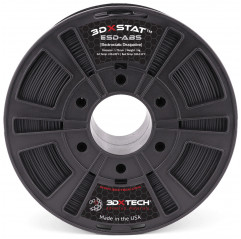Package Contains: 1 x 3DXSTAT ESD ABS - Black / 1.75mm / 1kg - 3DXTech
Target surface resistance: 10^7 to 10^9 Ohms. Compare with Stratasys® ABS-ESD7 in terms of performance and price and you'll never go back! Made using state-of-the-art multi-wall carbon nanotube technology, cutting-edge compounding technology and precision extrusion processes.
3DXSTAT? ESD ABS is an advanced ESD-Safe compound designed for use in critical applications requiring electrostatic discharge (ESD) protection and a high level of cleanliness. Manufactured with consistency in mind, 3DXTECH starts with premium ABS and then compounds it to a proprietary formulation of multi-walled carbon nanotubes, delivering a filament with excellent printing characteristics and consistent ESD properties.
Benefits of ABS include:
Durable and robust parts on virtually every machine on the market
Easier to print than most industrial-grade materials
Higher melting point and thermal properties than PLA or PETG
Ideal for prototyping or end-use parts among both industry engineers and hobbyists
3DXSTAT? advantages include:
Constant surface resistivity
Improved impact retention and elongation
Low particulate contamination
Minimal contribution to outgassing and ionic contamination
Typical ABS ESD applications include:
Semi-con: HDD components, wafer handling, masks, enclosures and connectors
Industrial: transportation, measurement and sensing applications
Target conductivity for 3DXSTAT ESD ABS:
Surface resistivity of 10^7 to 10^9 ohms on 3DP sample using concentric ring test method.
Note: Internal studies have indicated that increasing extruder temperatures can achieve higher levels of conductivity. Similarly, lower extruder temperatures have resulted in lower levels of conductivity. Each printer is configured differently as well as part geometry varies. Therefore, expect some testing time to understand how the ESD ABS filament works in your specific printer/application.
Surface conductivity as a function of extruder temperature:
The surface resistance of the ESD-safe printed part varies with the temperature of the printer extruder. For example, if the test indicates that the part is too insulating, increasing the extruder temperature will result in better conductivity. Therefore, surface resistance can be "made up" by adjusting the extruder temperature up or down depending on the reading you receive on the ESD ABS part.
Filament specifications:
Diameter: 1.75 mm (+/- 0.05 mm)
Recommended print settings:
Extruder: 220-240°C
Platen temperature: 100-110°C
Platen preparation: adhesive or poly tape is recommended
Heated chamber: recommended, a chamber helps reduce warpage.
Other: it may be necessary to increase the extrusion multiplier to 1.15 or even 1.2 and vary the fan speed between 50 and 100%.
Media: Water-soluble AquaTek X1 USM works great for complex parts.
Drying instructions: 80°C for 4 hours.









![ESD-FLEX [TPU] 3D FILAMENT - Black / 1.75mm / 750g - 3DXTech ESD-Safe 19210060 3DXTech](www.dhm-online.com/4900151-home_default/esd-flex-tpu-3d-filament-black-175mm-750g-3dxtech.jpg)


